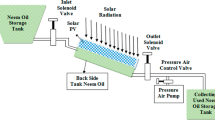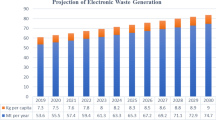Abstract
Polyethylene terephthalate (PET) and polymethyl methacrylate (PMMA) are extensively applied to produce nano-energy by harvesting ambient mechanical energy for energizing wearable electronics. Nowadays importance has been given to study on both PET and PMMA due to their growing demand in building Triboelectric Nanogenerators (TENG) to replace small batteries. The manufacturing of both triboelectric polymers from raw materials is hazardous to the environment. However, there has been no comparative evaluation of the probable effects of PET and PMMA production plants yet. This study highlights their comparative eco-profiles. An inclusive Life Cycle Inventory (LCI) model is built for methodical assessment of their impacts. Life Cycle Assessment (LCA) has been done by the ILCD midpoint method, Eco-indicator 99 endpoint method, Raw Material Flow (RMF) method, Greenhouse gas protocol method, and Ecopoints 97 method utilizing the Ecoinvent database and SimaPro software. The effects are assessed and compared for 21 impact categories such as global warming, acidification, eutrophication, terrestrial ecotoxicity, human toxicity, human carcinogenic toxicity, and fine particulate matter formation, marine ecotoxicity etc. The results indicate an estimated 3.01 kg CO2 eq./kg and 8.43 kg CO2 eq./kg of greenhouse gas (GHG) emission to the environment by a PET plant and a PMMA plant, respectively. Moreover, PET plants have the highest effect on land use, ionizing radiation and ozone depletion; whereas PMMA plants have the greatest impact on climate change, acidification, eutrophication and resources. Overall, PMMA polymer production plants are found to be more hazardous to the environment than PET polymer production plants. It is recommended that a better environmental profile from both types of production plants can be achieved through optimization, via abating the effects by replacing the problematic materials, designs, methods and devices with their equivalent environment-friendly options without compromising the quality and production rates.









Similar content being viewed by others
Abbreviations
- kg CO2eq.:
-
Carbon dioxide equivalent
- kg CFC-11 eq.:
-
Ozone Depletion Potential OZDP kg CFC-11 eq.
- CTUh:
-
Comparative Toxic Unit for human
- kg PM 2.5 eq.:
-
Unit for particulate matter
- kBq U235 eq.:
-
Unit for ionizing radiation (kilo Becquerel Uranium235 equivalent)
- kg NMVOC eq.:
-
Non-methane volatile organic compounds equivalent
- molc H + eq.:
-
Mole of Hydrogen equivalent
- molc N eq.:
-
Mole of Nitrogen equivalent
- kg P eq.:
-
Kilograms of Phosphorus equivalent
- kg N eq.:
-
Kilogram of Nitrogen equivalent
- kg C deficit:
-
Kilogram of Carbon deficit
- CTUe:
-
Comparative Toxic Unit for ecosystems
- m3 H2O eq.:
-
Volume of water supply equivalent
- kg Sb eq.:
-
Kilogram of Antimony equivalent
- kg SO2eq.:
-
Kilogram of sulphur di oxide equivalent
- kg O3eq.:
-
Kilogram of ozone equivalent
- DALY:
-
Disability adjusted life year
- PDF*m2*yr.:
-
Potentially Disappeared Fraction of species over a certain area over a certain time
- MJ surplus:
-
Total life cycle surplus energy use
References
Heijungs R. Ecodesign - Carbon Footprint - Life Cycle Assessment - Life Cycle Sustainability Analysis. A Flexible Framework for a Continuum of Tools. Environ Clim Technol 2010;4:42–6.doi:https://doi.org/10.2478/v10145-010-0016-5.
Goedkoop M, Oele M, Vieira M, Leijting J, Ponsioen T, Meijer E. SimaPro Tutorial 2014:89.doi:https://doi.org/10.1142/S0218625X03005293.
PRé. SimaPro Database Manual Methods Library Colophon Title: SimaPro Database Manual Methods Library 2018.doi:https://doi.org/10.1017/CBO9781107415324.004.
Askari H, Hashemi E, Khajepour A, Khamesee MB, Wang ZL (2018) Towards Self-Powered Sensing Using Nanogenerators for Automotive Systems. Nano Energy 53:1003–1019. https://doi.org/10.1016/j.nanoen.2018.09.032
Mahmud MAP, Huda N, Farjana SH, Lang C (2019) Techno-economic operation and environmental life-cycle assessment of a solar PV-driven islanded microgrid. IEEE Access 7:111828–111839
Mahmud MAP, Huda N, Farjana SH, Lang C (2020) Life-cycle impact assessment of renewable electricity generation systems in the united states. Renewable Energy 151:1028–1045
Wang N, Zou J, Yang Y, Li X, Guo Y, Jiang C et al (2018) Kelp-inspired biomimetic triboelectric nanogenerator boosts wave energy harvesting. Nano Energy. https://doi.org/10.1016/j.nanoen.2018.11.006
Mahmud MAP, Huda N, Farjana SH, Lang C (2019) Comparative life cycle environmental impact analysis of lithium-ion (LiIo) and nickel-metal hydride (NiMH) batteries. Batteries 5(1):22–28
Mahmud MAP, Ejeian F, Azadi S, Myers M, Pejcic B, Abbassi R, Razmjou A, Asadnia M (2020) Recent progress in sensing nitrate, nitrite, phosphate, and ammonium in aquatic environment. Chemosphere 259:127492
Zhu Z, Xia K, Xu Z, Zhang H (2018) A triboelectric nanogenerator based on polypropylene carbonate and photoacid generator. Solid State Electron 148:16–19. https://doi.org/10.1016/j.sse.2018.07.010
Mahmud MAP, Huda N, Farjana SH, Asadnia M, Lang C. Recent Advances in Nanogenerator-Driven Self-Powered Implantable Biomedical Devices. Adv Energy Mater 2018;8.doi:https://doi.org/10.1002/aenm.201701210.
Farjana SH, Huda N, Mahmud MAP (2019) Impacts of aluminum production: A cradle to gate investigation using life-cycle assessment. Sci Total Environ 663:958–970
Jenkins K, Kelly S, Nguyen V, Wu Y, Yang R (2018) Piezoelectric diphenylalanine peptide for greatly improved flexible nanogenerators. Nano Energy 51:317–323. https://doi.org/10.1016/j.nanoen.2018.06.061
Farjana SH, Huda N, Mahmud MAP, Lang C (2019) A global life cycle assessment of manganese mining processes based on ecoinvent database. Sci Total Environ 688:1102–1111
Nie X, Bingxue J, Chen N, Liang Y, Han Q, Qu L. Gradient doped polymer nanowire for moistelectricnanogenerator.NanoEnergy2018;46:297–304. doi:https://doi.org/10.1016/j.nanoen.2018.02.012.
Ding P, Chen J, Farooq U, Zhao P, Soin N, Yu L, et al. Realizing the potential of polyethylene oxide as new positive tribo-material: Over 40 W/m2high power flat surface triboelectric nanogenerators Nano Energy 2018;46:63–72. doi:https://doi.org/10.1016/j.nanoen.2018.01.034.
Auras RA, Singh SP, Singh JJ. Evaluation of oriented poly(lactide) polymers vs. existing PET and oriented PS for fresh food service containers. Packag Technol Sci 2005;18:207– 16. doi:https://doi.org/10.1002/pts.692.
Lehtinen H, Saarentaus A, Rouhiainen J, Pits M, Azapagic A. A review of LCA methods and tools and their suitability for SMEs. Eco- Innov Biochem 2011:24. doi:https://doi.org/10.1017/CBO9781107415324.004.
Lee SG, Xu X (2005) Design for the environment: life cycle assessment and sustainable packaging issues. Int J Environ Technol Manag 5:14. https://doi.org/10.1504/IJETM.2005.006505
Weidema BP, Bauer C, Hischier R, Mutel C, Nemecek T, Reinhard J, et al. Data quality guideline for the Ecoinvent database version 32013;3:169.
Hischier R, Weidema B, Althaus H-J, Bauer C, Doka G, Dones R, et al. Implementationof Life Cycle Impact Assessment Methods Data v2.2 (2010). Ecoinvent Rep No 32010:176.
European Commission -- Joint Research Centre -- Institute for Environment and Sustainability. International Reference Life Cycle Data System (ILCD) Handbook -- General guide for Life Cycle Assessment -- Detailed guidance. 2010.doi:https://doi.org/10.2788/38479.
(JRC) I forth e E and S in the EC JRC. ILCD handbook.vol.2012.2012. https://doi.org/10.278/33030.
Canda L, Heput T, Ardelean E. Methods for recovering precious metals from industrial waste. IOP Conf Ser Mater Sci Eng 2016;106.doi:https://doi.org/10.1088/1757-899X/106/1/012020.
Farjana SH, Huda N, Mahmud MAP, Lang C. Towards sustainable TiO2 production: An investigationofenvironmentalimpactsofilmeniteandrutileprocessingroutesinAustralia. J Clean Prod 2018;196.doi:https://doi.org/10.1016/j.jclepro.2018.06.156.
Scientific Applications International Corporation (SAIC), Drive 11251 Roger Bacon, Reston V 20190. Life Cycle Assessment: Principles and Practice.2006.
Roisin BR. Life-Cycle Assessment (LCA) 2008:1–21.
Pehnt M (2006) Dynamic life cycle assessment (LCA) of renewable energy technologies. Renew Energy 31:55–71. https://doi.org/10.1016/j.renene.2005.03.002
Kikuchi Y, Hirao M, Sugiyama H, Papadokonstantakis S, Hungerbühler K, Ookubo T, et al. LCA OF WASTE MANAGEMENT SYSTEMS Design of recycling system for poly(methylmethacrylate)(PMMA).Part2:processhazardsandmaterialflowanalysis.Int J Life Cycle Assess 2014;19:307–19.doi:https://doi.org/10.1007/s11367-013-0625-x.
Kikuchi Y, Hirao M (2009) Hierarchical activity model for risk-based decision making: Integrating life cycle and plant-specific risk assessments. J Ind Ecol 13:945–964. https://doi.org/10.1111/j.1530-9290.2009.00180.x
Patel M, Marscheider-Weidermann F, Schleich J, Husing B, Angerer G (2005) Techno-economic feasibility of large-scale production of bio-based polymers in Europe. LF-NA-22103-EN-CISBN:92-79-01230-4
Patel M, Bastioli C, Marini L, Würdinger E (2003) Life-cycle Assessment of Bio-based Polymers and Natural Fiber Composites. Biopolym Online. https://doi.org/10.1002/3527600035
Perugini F, Mastellone ML, Arena U (2004) Environmental aspects of mechanical recycling of PE and PET: A life cycle assessment study. Prog Rubber, Plast Recycl Technol 20:69–84
Song X, Pettersen JB, Pedersen KB, Røberg S (2017) Comparative life cycle assessment of tailings management and energy scenarios for a copper ore mine: A case study in Northern Norway. J Clean Prod 164:892–904. https://doi.org/10.1016/j.jclepro.2017.07.021
Romero-HernándezO,RomeroHernándezS,MuñozD,Detta-SilveiraE,Palacios-BrunA, LagunaA.Environmentalimplicationsandmarketanalysisofsoftdrinkpackagingsystems in Mexico. A waste management approach. Int J Life Cycle Assess 2009;14:107–13. doi:https://doi.org/10.1007/s11367-008-0053-5.
Detzel A (2006) Life cycle assessment of polylactide (PLA). IFEU GmbH, Heidelb
Shen L, Nieuwlaar E, Worrell E, Patel MK (2011) Life cycle energy and GHG emissions of PET recycling: Change-oriented effects. Int J Life Cycle Assess 16:522–536. https://doi.org/10.1007/s11367-011-0296-4
Fogler S, Timmons D. An Overview of the ISO 14040 Life Cycle Assessment Approach and an Industrial Case Study. Argentum V1998.
Mahmud MAP, LEE JJ, Kim G., Lim H., Choi K.-B., Improving the surface charge density of a contact separation based triboelectric nanogenerator by modifying the surface morphology, Microelectronic Engineering 159 (2016) 102–107.
Farjana SH, Huda N, Mahmud MAP (2019) Life cycle analysis of copper-gold-lead-silver-zinc beneficiation process. Sci Total Environ 659:41–52
E. N. Bakatula EMC& HT. Biosorption of metals from gold mine wastewaters by Penicillium simplicissimum immobilized on zeolite: Kinetic, equilibrium and thermodynamic studies. Czech Geol Surv 2012:1–30. doi:https://doi.org/10.1016/B978-0-444-52858- 2.00007–4.
Kucinskis G (2010) Kinetic Behavior of LiFePO4/C Thin Film Cathode Material for Lithium-Ion Batteries. Environ Clim Technol 4:53–57. https://doi.org/10.2478/v10145-010-0018-3
Sciences E, Valters K. Environmental and climate technologies issn 1691–5208 vides un klimata2009.
Mahmud MAP, Hossain MJ, Nijami MSH, Rahman MS, Farjana S, Huda N, Lang C, Advanced power routing framework for optimal economic operation and control of solar photovoltaic-based islanded microgrid, IET Smart Grid 2 (2019) 242–249(7).
Mahmud MAP, Huda N, Farjana SH. Environmental profile evaluations of piezoelectric polymers using life cycle assessment Environmental profile evaluations of piezoelectric polymers using life cycle assessment2018.
Mahmud MAP, Huda N, Farjana S, Lang C, Environmental Impacts of Solar-Photovoltaic and Solar-Thermal Systems with Life-Cycle Assessment. Energies 2018, Vol 11, Page 2346 2018;11:2346.doi:https://doi.org/10.3390/EN11092346.
Farjana SH, Huda N, Mahmud MAP, Saidur R (2018) Solar process heat in industrial systems – A global review. Renew Sustain Energy Rev 82:2270–2286. https://doi.org/10.1016/j.rser.2017.08.065
Farjana SH, Huda N, Mahmud MAP, Saidur R. Solar industrial process heating systems in operation – Current SHIP plants and future prospects in Australia. Renew Sustain Energy Rev 2018;91.doi:https://doi.org/10.1016/j.rser.2018.03.105.
Hischier R. (2007) Life cycle inventories of packaging and graphical paper. Final report ecoinvent data v2.0 No. 11. EMPA, Swiss Centre for Life Cycle Inventories, Dubendorf, CH, online version under: www.ecoinvent.org.
Dhanushkodi S, Wilson VH, Sudhakar K (2015) Life cycle cost of solar biomass hybrid dryer systems for cashew drying of nuts in India. Environ Clim Technol 15:22–33. https://doi.org/10.1515/rtuect-2015-0003
Farjana SH, Huda N, Mahmud MAP, Lang C (2018) Comparative Life-cycle Assessment of Uranium Extraction Processes in Australia. J Clean Prod 202:666–683. https://doi.org/10.1016/j.jclepro.2018.08.105
Farjana SH, Huda N, Mahmud MAP. Environmental impact assessment of European non-ferrominingindustriesthroughlife-cycleassessment.IOPConf.Ser.EarthEnviron. Sci., vol. 154, 2018. doi:https://doi.org/10.1088/1755-1315/154/1/012019.
Farjana SH, Huda N, Mahmud MAP. Life-Cycle environmental impact assessment of mineral industries. IOP Conf. Ser. Mater. Sci. Eng., vol. 351, 2018. doi:https://doi.org/10.1088/1757- 899X/351/1/012016.
Mahmud MAP, Huda N, Farjana SH, Lang C. Environmental sustainability assessment of hydropower plant in Europe using life cycle assessment. IOP Conf. Ser. Mater. Sci. Eng., vol. 351, 2018.doi:https://doi.org/10.1088/1757-899X/351/1/012006.
Author information
Authors and Affiliations
Corresponding author
Additional information
Publisher's Note
Springer Nature remains neutral with regard to jurisdictional claims in published maps and institutional affiliations.
Rights and permissions
About this article
Cite this article
Mahmud, M.A.P., Farjana, S.H. Comparative Eco-Profiles of Polyethylene Terephthalate (PET) and Polymethyl Methacrylate (PMMA) Using Life Cycle Assessment. J Polym Environ 29, 418–428 (2021). https://doi.org/10.1007/s10924-020-01885-7
Published:
Issue Date:
DOI: https://doi.org/10.1007/s10924-020-01885-7




